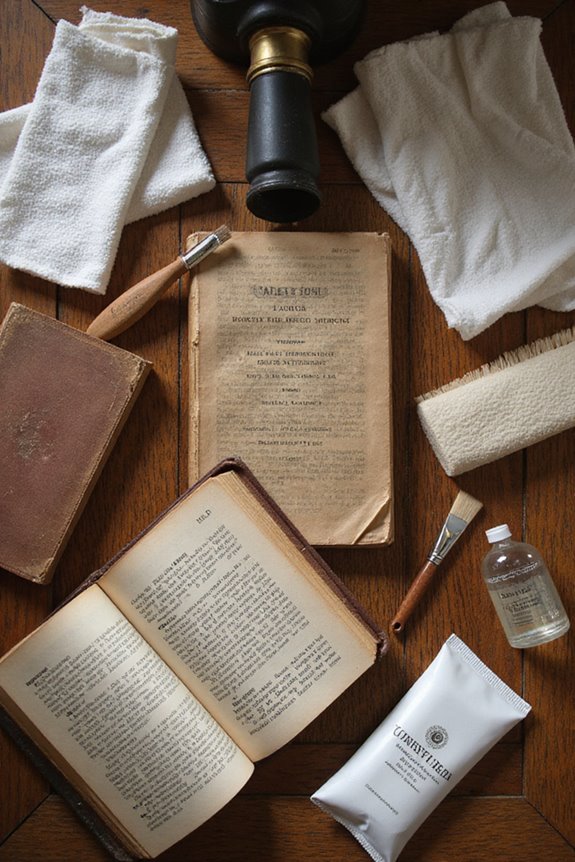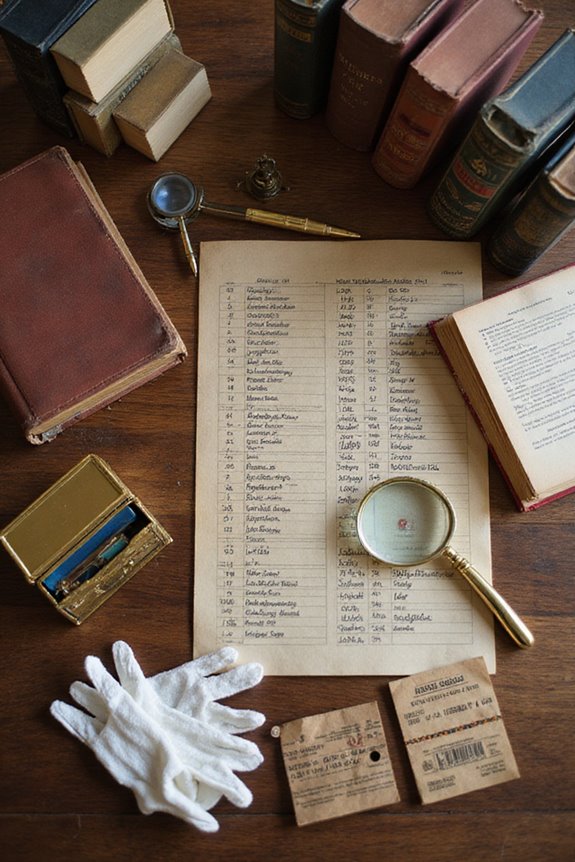To clean dusty books safely, we first need to identify the type of book we’re dealing with. For hardcovers, use a soft brush to gently remove dust, or a damp cloth for tough stains—avoiding saturation! Paperbacks require extra care; keep moisture minimal while brushing off dust. Always store books in a dry spot to prevent mold. And if you stick around, we’ll share tips on how to handle tougher issues like mold and proper storage!
Key Takeaways
- Use a soft-bristled brush or a HEPA vacuum with a soft brush attachment to gently remove dust without damaging the book’s surface.
- For hardcover books, use a damp microfiber cloth with diluted dish soap for tough stains; avoid soaking the pages.
- Carefully handle paperback books to prevent moisture damage; use brushes and soft cloths for gentle cleaning.
- Keep your workspace clutter-free and well-lit to concentrate on cleaning, minimizing distractions and preventing accidents.
- Store books in a cool, dry place to prevent mold and further dust accumulation between cleanings.
Identify the Type of Book
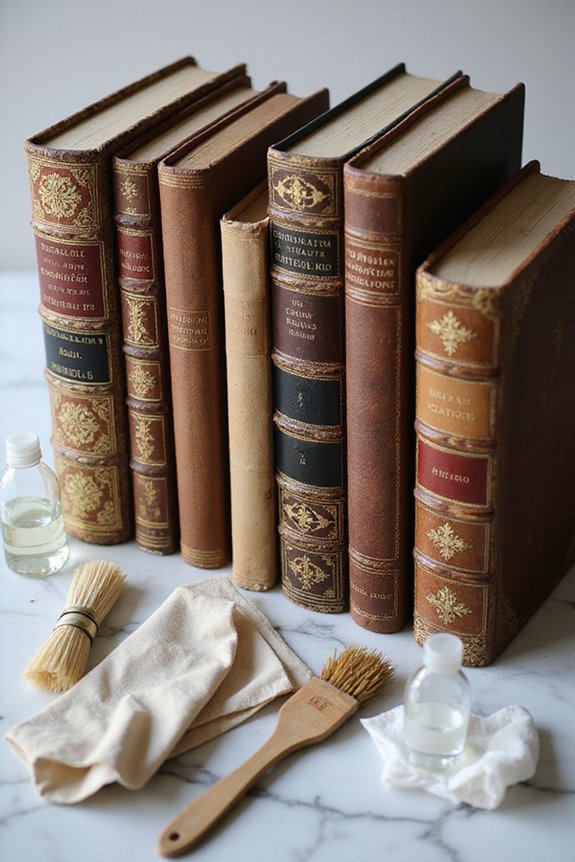
When we clean dusty books, it’s essential to first identify the type of book we’re dealing with because different formats and materials require various care methods. For example, hardcover books may need gentle dusting, while paperbacks can be more prone to bending. Don’t forget about the genre classification—fiction books often have no special materials, while collectible leather-bound editions might require extra care.
Kids’ books can get sticky from little hands, and oversized art books, well, they just call for extra attention to avoid fingerprints. Let’s remember that antique or rare books can be fragile, and we need to approach them with utmost caution. By knowing these book types, we can clean without causing damage, keeping our collections looking great!
Gather Necessary Cleaning Tools
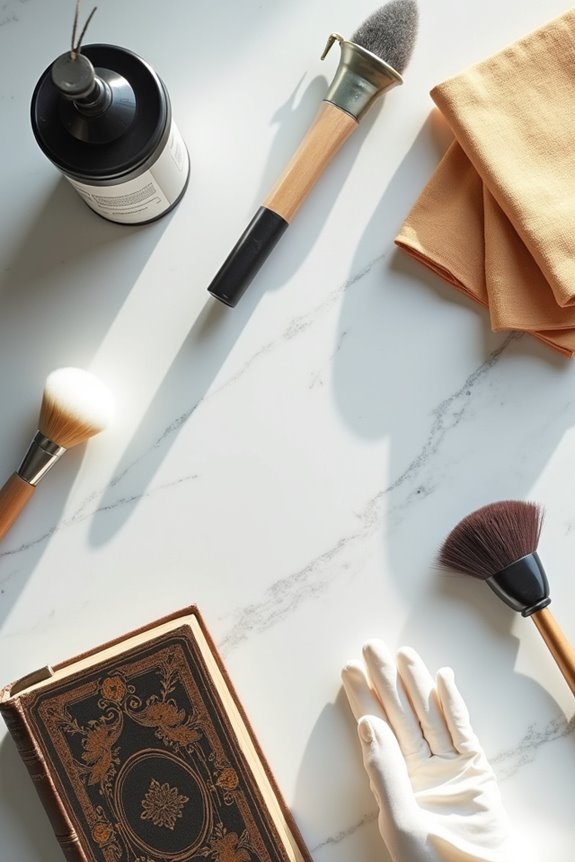
Gathering the right cleaning tools is essential for keeping our dusty books in top shape. First, we need to identify appropriate brushes, like soft artists’ brushes for delicate surfaces and HEPA vacuum brushes for heavier dust. Micro tool sets are great for those hard-to-reach spots, while dust wands can gently sweep page edges, ensuring effective dust prevention.
When it comes to cloths, let’s choose magnetic cloths for lightly soiled books or soft dust rags for sturdier options. Remember, we should avoid microfiber cloths since they may leave unwanted residues. Also, investing in a HEPA vacuum with variable speed control will help protect sensitive areas of our books. With these tools in hand, we’re now ready to tackle the dust!
Prepare Your Work Space
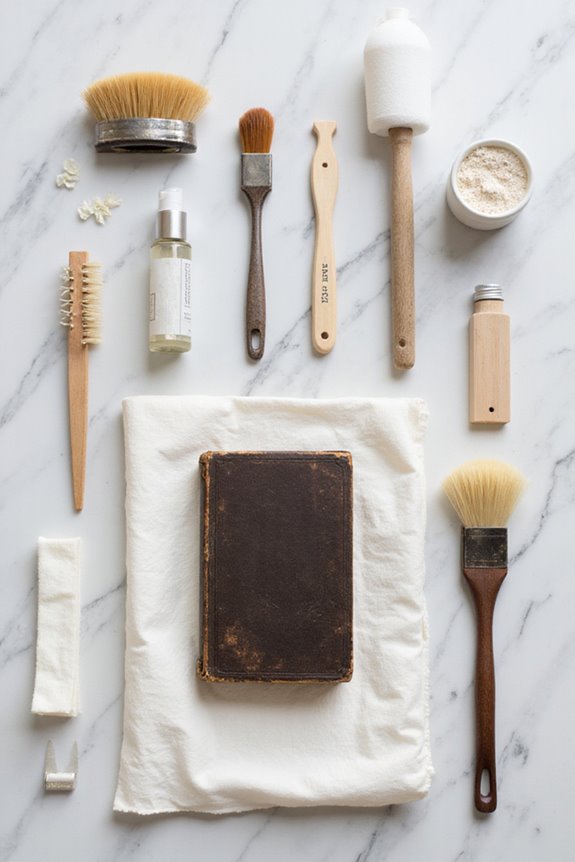
Now that we’ve got our cleaning tools sorted, it’s time to set up an efficient workspace. First, let’s clear away any clutter that might distract us. Next, we should guarantee good lighting; trust us, squinting at dusty books isn’t fun! Cover your surfaces with protective cloths to keep them safe from any cleaning supplies we’ll be using. To minimize distractions, silence those buzzing devices. It’s also wise to designate a cleaning station where we can easily access our organized supplies. Using labeled containers will speed up our workflow, too. Finally, position everything ergonomically to keep strain at bay while we immerse ourselves in the task ahead. A well-prepared workspace makes all the difference, don’t you think?
Remove Loose Dust Effectively
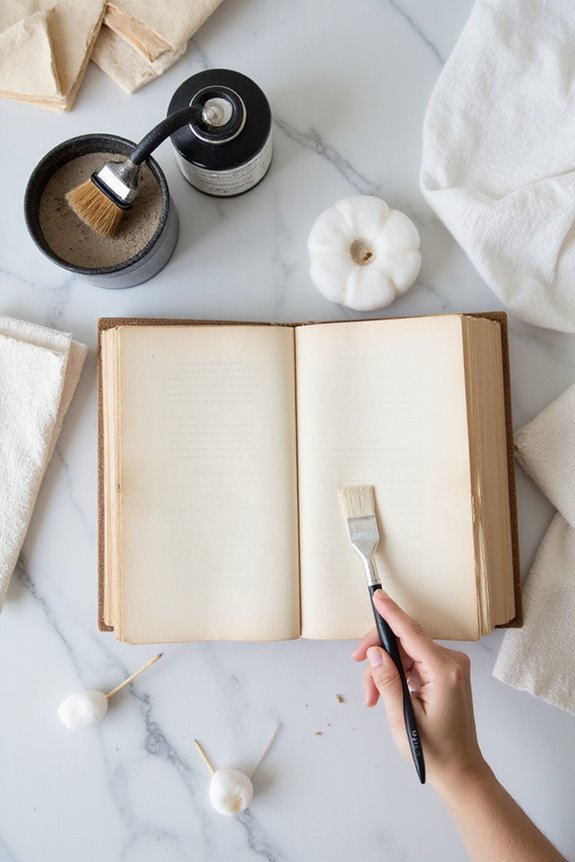
To effectively remove loose dust from our beloved books, let’s explore some practical methods that guarantee we keep them in great shape. First, we should
Clean Hardcover Books
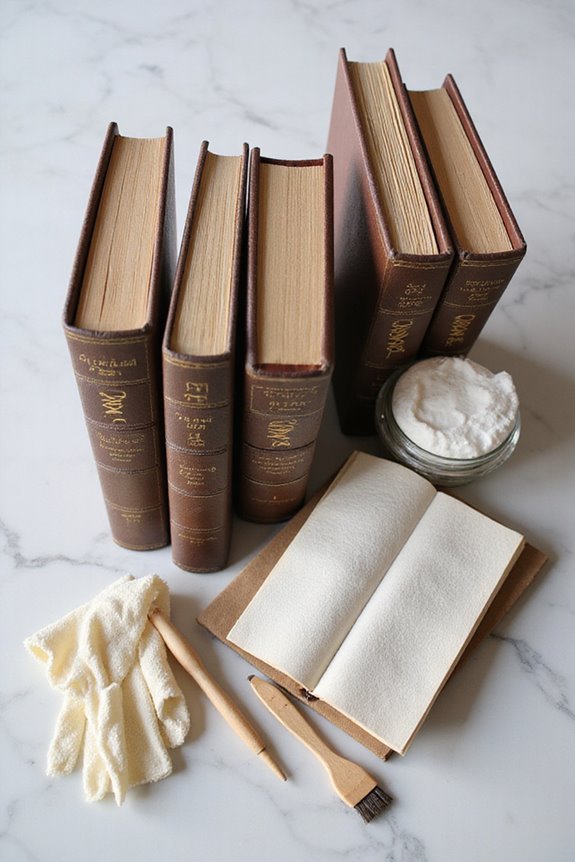
When it comes to cleaning our hardcover books, we want to make sure we’re being gentle yet effective. First, let’s employ a soft-bristled brush to remove dust and loose dirt from the cover; this simple act is essential for maintaining good hardcover care. For fabric covers, a damp microfiber cloth works wonders—just remember, no soaking! If tougher stains pop up, we can use diluted dish soap on a cloth, but let’s avoid saturating the book. For heavy dust, a HEPA vacuum with a soft brush attachment can save the day. After cleaning, allow our books to air dry completely before storing them. By following these cleaning techniques, we can enjoy our treasured hardcover books for years to come!
Handle Paperback Books With Care
As we take care of our beloved hardcover books, it’s important to remember that paperbacks require just as much attention—if not a bit more gentle handling. When handling our paperbacks, let’s be mindful of book cover care. Avoid excessive moisture, which can warp covers and damage the adhesive binding. Instead, we can use soft-bristled brushes and microfiber cloths to carefully remove dust without scratching the surface. And remember, harsh chemicals are a no-go! For stubborn stains, applying a small amount of rubbing alcohol on a cloth works wonders, but make sure it’s not too wet. Storing our books in a cool, dry place also helps preserve their condition, preventing issues like mold or damage. Happy reading!
Safely Remove Mold From Books
Mold is a pesky problem that can afflict our beloved books, but don’t worry! First, let’s assess the situation in a well-ventilated area while wearing gloves and a mask to keep those spores at bay. If mold’s visible, we can use a HEPA vacuum with a soft brush, gently loosening the mold and guiding it toward the nozzle. For stubborn spots, a cloth dampened with denatured alcohol works wonders. Remember, if cleaning isn’t possible right away, freeze damp books to halt mold growth. To prevent future mold, we need to maintain low humidity and guarantee good air circulation. Regularly checking our precious volumes will help keep mold at bay—after all, a little prevention goes a long way!
Store Cleaned Books Properly
Properly storing our cleaned books is key to preserving their condition and longevity. For ideal book storage, we should use steel shelving with powder-coated finishes, which minimizes harmful acidic off-gassing. When placing our books, let’s verify they’re standing upright and squarely on their bases with book supports to avoid damage. It’s crucial to keep them away from direct sunlight and provide good air circulation; after all, we don’t want our precious books to fade or get musty! Additionally, let’s maintain consistent temperature and moderate humidity levels to promote environmental stability. Keeping books at least 3 to 4 inches off the floor protects them from moisture. A little attention goes a long way in safeguarding our valuable collections!
Implement Regular Maintenance Practices
Regularly implementing maintenance practices is essential for keeping our dusty books in great condition. We should schedule dusting sessions every few months to prevent dust accumulation. Using soft brushes or microfiber cloths is key for gently removing dust from covers and edges without damaging them. And let’s avoid feather dusters; they can push dust into page edges! During our cleaning, we should watch for signs of mold, mildew, or insect damage, noting any books needing repair. It’s also wise to keep our storage areas clean and well-ventilated. Finally, educating ourselves and others on gentle handling techniques can help maintain our books’ integrity and aesthetic. A little regular upkeep goes a long way in preserving our beloved volumes!
Frequently Asked Questions
Can I Use Wet Wipes to Clean Book Covers?
We can use wet wipes to clean some book covers, especially glossy ones, but we should be cautious. Always spot test first and avoid paper or cloth covers to prevent damage.
How Often Should I Clean My Books?
Isn’t it satisfying to see our books looking pristine? Regarding cleaning frequency, regular book maintenance is essential—dusting them every few months helps prevent buildup and keeps our cherished collections in great shape for years.
Are There Any Cleaning Products I Should Avoid?
When it comes to cleaning books, we should avoid harmful solvents and anything that leaves chemical residues. Instead, let’s stick to gentle tools like microfiber cloths to preserve the integrity of our beloved books.
Is It Safe to Clean Vintage Books the Same Way?
Did you know that nearly 60% of vintage books suffer damage from improper cleaning? We should definitely use safe cleaning methods tailored for vintage book preservation, ensuring we protect their delicate bindings and fragile pages during the process.
What Should I Do if the Pages Stick Together?
If we find our pages sticking together, let’s carefully separate them using moisture-free methods to protect against moisture damage. Remember, preserving our books is key to maintaining their integrity for future enjoyment.

